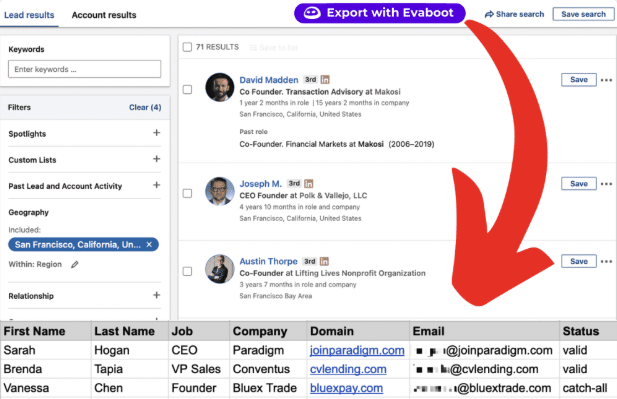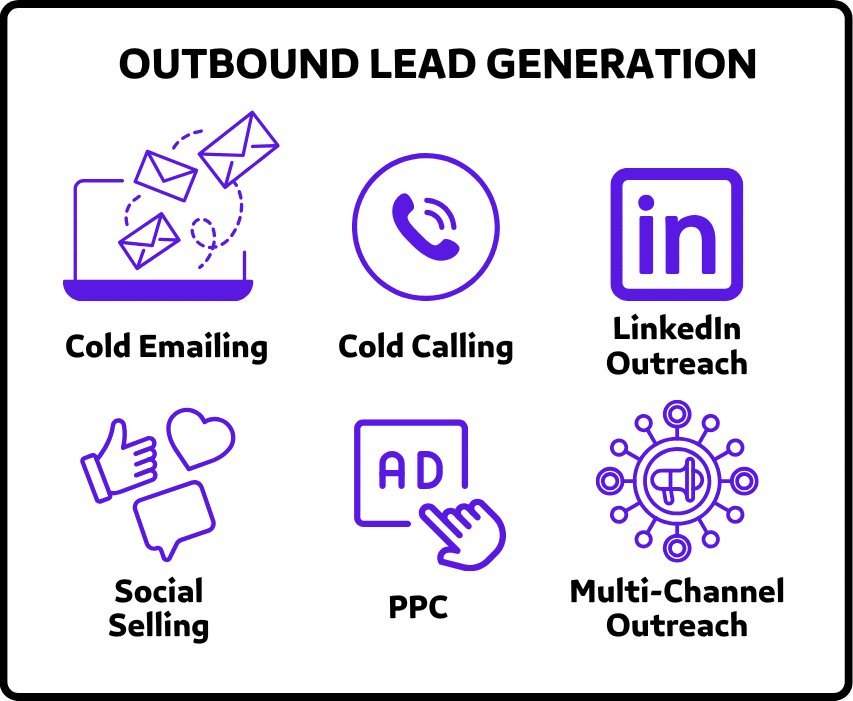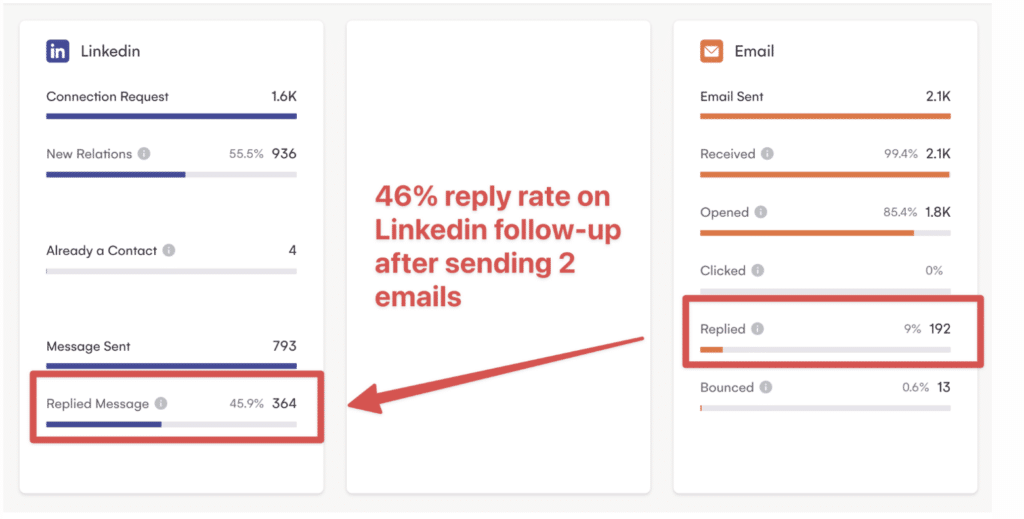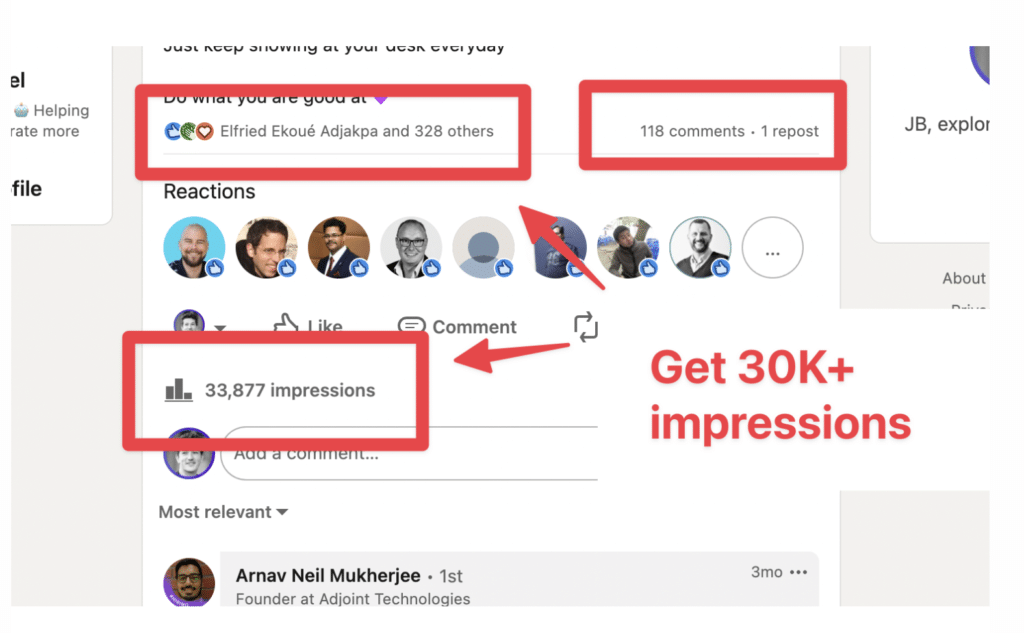Export Leads From Sales Navigator

Create a clean B2B email list from LinkedIn Sales Navigator in just one click with the Evaboot Chrome Extension.
Export Leads From Sales Navigator

Create a clean B2B email list from LinkedIn Sales Navigator in just one click with the Evaboot Chrome Extension.
Contents
Using outbound lead generation can help you find high-quality leads to build your sales pipeline.
From cold emailing and cold calling to LinkedIn outreach, pay-per-click (PPC) ads, social selling and multi-channel outreach, the tactics may vary, but the goal remains the same: finding and converting qualified leads fast.

But let’s face it, outbound campaigns can feel like a grind without the right process.
That’s why this guide unpacks the full outbound lead generation process and dives deep into what truly works in 2025.
We’ll explore:
Let’s get started.
Outbound lead generation means proactively looking for prospects you can nurture and convert.
Think of prospects as your ideal customer profile (ICP).
This process involves using sales tactics, such as email marketing, cold calling, or direct messaging potential leads on LinkedIn.

With outbound lead generation, your goal is to identify leads that are relevant to your business.
You can then pass on your generated leads to your marketing and sales teams. They’ll use your list to conduct outbound sales activities, like sending segmented email campaigns or booking warm demo calls.
Below, we’ll cover the key building blocks that form the foundation of effective outbound lead generation:
The foundation of any successful outbound lead generation effort is a clearly defined Ideal Customer Profile (ICP) and detailed buyer personas.
Without this segmentation, your outreach efforts will lack focus, resulting in wasted resources and poor conversion rates.
Your ICP should outline the specific attributes of companies that represent your perfect fit customers. This includes demographics such as company size, geographic location, annual revenue, and technology stack.

Beyond company-level targeting, developing detailed buyer personas helps you understand the individual decision-makers within those organizations.
These personas should capture information about their roles, responsibilities, goals, challenges, and pain points.

Understanding what keeps your potential customers up at night allows you to craft messages that resonate on a personal level.
Luckily, you can easily do this segmentation by using a tool like LinkedIn Sales Navigator:
Once you’ve defined who you’re targeting, the next strategic decision involves selecting the most effective channels to reach them.
Different target audiences respond to different communication methods, and the most successful outbound lead generation programs typically employ multiple channels working in concert.

The success of your outbound sales lead generation depends on how well you communicate your value to potential customers.
You must craft compelling value propositions that directly address your prospect’s pain points. Generic outreach gets ignored—especially in today’s crowded B2B space.
To stand out, start with deep research into your target audience.

Review industry publications, social media discussions, and competitor messaging to identify common challenges. Conduct interviews with existing customers to understand what motivated them to seek a solution like yours.
Focus on concrete outcomes and results rather than features or technical specifications.
For example, instead of highlighting your platform’s automation capabilities, emphasize how it reduces manual work by 75% and frees up 10 hours per week for strategic activities.
Scaling your efforts requires strategic use of automation and well-designed workflows.
The right balance of technology and human touch allows your sales team to reach more prospects without sacrificing the quality of interactions.
Modern automation tools can handle many repetitive aspects of outbound campaigns, including email sending, follow-up scheduling, data entry, and basic lead qualification.

This frees your sales reps to focus on high-value activities like personalized research, meaningful conversations, and relationship building.
Effective workflows coordinate the timing and sequencing of your outreach activities across channels.
For example, a well-designed workflow might begin with a personalized cold email, followed by a connection request on LinkedIn two days later, then a phone call three days after that.
With your strategy in place, it’s time to implement proven outbound lead generation tactics that drive results:
Cold email remains one of the most cost-effective and scalable outbound lead generation tactics. But to stand out, your campaigns need to be ultra-targeted.
Forget the one-and-done email blast. Structure a sequence of 4–6 emails to build momentum.
Start with a short, personalized message aimed at starting a conversation—not closing a deal. Follow up with additional value, address common objections, and include stronger calls to action.
And remember that subject lines can make or break your open rates. The most effective B2B cold email subject lines are typically under 50 characters, create curiosity, and feel personal.

To save time finding email addresses, use Evaboot to grab them from LinkedIn Sales Navigator.
Evaboot, a smart LinkedIn Sales Navigator scraping and email-finding tool that automatically filter and clean Sales Navigator lead lists.
This feature is not native to LinkedIn Sales Navigator, so you must download the Evaboot extension first.
After, all you have to do is run Evaboot, and within seconds, it will pull all the data you need and export it as a neat CSV file.
1. Click the extension button on the top right of your Sales Navigator page.

2. It’ll redirect to the Evaboot dashboard, where you can launch the export.

Once the export is done, you can download the email lists with all the other lead information needed to personalize your outreach messages.
Another great thing about Evaboot is that it does not give you false emails.

If the address is risky or old, it will be excluded from the list.
This means you can import the exported file to a CRM or outreach software and launch your campaign without concern.

Here’s the kind of contact data you get:
This is an excellent feature for using cold emails by improving the quality of your leads lists.
Evaboot’s pricing is credit-based.
The most basic pricing plan starts at $9 for 100 credits.

With Evaboot, you don’t have to worry about the quality, false-positive results, or legality of the data.
You’ll have GDPR-compliant and verified emails ready to exploit in your next outreach campaign.
Despite the rise of digital communication channels, cold calling remains a powerful outbound lead generation tactic, particularly for complex B2B sales.
Building effective call scripts is essential for cold calling success, but these should serve as flexible frameworks rather than rigid scripts.
Start with a strong opening that quickly establishes relevance and captures attention.
For example: “Hi [Name], I’m calling because we’ve helped [similar companies] reduce their customer acquisition costs by 30% through our specialized outbound lead generation approach.”
Overcoming objections is an inevitable part of cold calling.
Prepare thoughtful responses to common objections like “we’re happy with our current solution” or “we don’t have budget right now.”
The key is to acknowledge the objection, respond with empathy and insight, and then redirect the conversation toward value.
And if you’re looking to get phone numbers from LinkedIn and Sales Navigator to launch cold calling campaigns, I got you covered with this video:
LinkedIn has become an indispensable platform for B2B outbound lead generation.
Its rich targeting capabilities and professional context make it uniquely valuable to find and connect with decision-makers.
Wondering how to reach out to someone on LinkedIn? Use the RABT formula—Reason, Ask, Backup, Tease—to make your invite stand out.
Start with a real reason for reaching out (shared connection, post, or group). Ask a thoughtful, open-ended question. Back it up with relevant data or experience. Then, tease a helpful solution without going full sales mode.

You can also use LinkedIn Sales Navigator to better find and engage with potential leads.
Its advanced search filters allow you to target prospects based on specific criteria such as industry, company size, job title, and geographic location.
The most effective outbound lead generation programs don’t rely on a single channel but instead coordinate efforts across multiple touchpoints.
Multi-channel outreach recognizes that prospects have different communication preferences and that repeated exposure across channels significantly increases response rates.
Integrating email, phone, and social channels creates a cohesive experience that reinforces your message and increases the likelihood of connecting with prospects.
For example, you might start with a personalized cold email, follow up with a LinkedIn connection request two days later, and then make a phone call referencing both previous touchpoints.

There are many tools out there to build multi-channel sequences, like this one on LaGrowthMachine:

LaGrowthMachine (LGM) is a multichannel outreach tool that allows you to combine LinkedIn, email, and Twitter messages to reach out to your leads. It’s a huge time saver and one of my favorite LinkedIn automation software.
And don’t forget that measurement across channels is essential for optimizing your multi-channel outreach strategy. Track not only channel-specific metrics like email open rates or call connection rates but also how prospects move through your entire sequence.
Social selling has emerged as a powerful complement to traditional outbound tactics. It allows sales professionals to build relationships, demonstrate expertise, and engage prospects in a less intrusive manner.
Engaging leads on social media platforms requires a thoughtful approach focused on adding value rather than immediate selling.
Follow relevant prospects and companies, and regularly interact with their content through thoughtful comments that demonstrate your expertise and insight.
Here are 9 tips to grow your followers on LinkedIn and become a LinkedIn Influencer:
With your influencer status, you attract the attention of other top voices and potential business partners. This leads to increasing your professional network.
Don’t be surprised if you receive InMails or connection requests from other LinkedIn influencers or industry leaders, with a proposal of new business opportunities or collaborations.

LinkedIn Groups also provide excellent opportunities for social selling by allowing you to join conversations where your target audience is already engaged.
Participate actively by answering questions, sharing relevant resources, and offering constructive perspectives.
While many consider pay-per-click advertising primarily an inbound tactic, strategic use of PPC and retargeting can effectively support your outbound lead generation efforts.
These paid approaches allow you to reach specific segments of your target audience with precision.
Focus on highly specific keywords that indicate purchase intent or awareness of the problems your solution addresses.
Develop landing pages that align perfectly with your ad messaging and offer valuable content in exchange for contact information.
Retargeting ads for abandoned leads can significantly increase conversion rates by maintaining visibility with prospects who have shown initial interest but haven’t taken the next step.
And if you’re planning to create ads on LinkedIn, here’s a strategy I recommend to hack LinkedIn Ads with Sales Navigator:
In today’s B2B world, effective outbound lead generation separates growing companies from those stuck in place.
Turn scattered efforts into a scalable engine by applying the strategies in this guide.
Start with a clear ICP, launch personalized multi-channel campaigns, and use automation without losing the human touch.
Remember—outbound isn’t a one-and-done play. Test, measure, and optimize continuously.
That’s how you boost results and lower costs over time.
The main tasks of outbound lead generation focus on proactively identifying and engaging potential customers.
Sales reps start by defining their Ideal Customer Profile (ICP), then build targeted lists of qualified leads using B2B prospecting tools.
They launch cold outreach campaigns through channels like email, LinkedIn, and cold calling, tailoring each message to the lead’s pain points and needs.
Other key tasks include:
Each action moves leads further down the sales funnel, guiding them toward becoming a sales qualified lead (SQL).
The cost of lead generation depends on your strategy, tools, and the quality of leads you’re targeting.
Here’s a quick breakdown:
To stay cost-effective, optimize your segmentation, outreach workflows, and tools to increase your conversion rates.
Outbound lead generation tools are software solutions that help identify, contact, and manage leads more efficiently.
They fall into several categories:
Using the right combination of tools ensures your sales team runs scalable and personalized outbound campaigns.
Getting enough leads starts with a solid lead generation process.
Start by clearly defining your ICP—know your target audience’s demographics, roles, and company size.
Use tools like Evaboot combined with LinkedIn Sales Navigator to find and extract contacts that match your profile.
Then:
When done right, you can consistently generate hundreds of quality leads per week for cold outreach.
Yes, Google Ads can be highly effective for B2B lead generation, especially when combined with a solid outbound sales strategy.
Here’s why:
However, PPC can get expensive.
To make the most of it:
When integrated with cold outreach, PPC becomes a powerful way to fill your pipeline with warm leads.